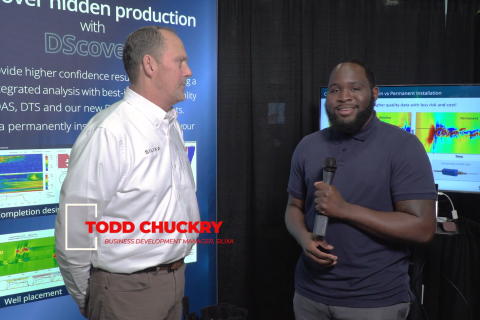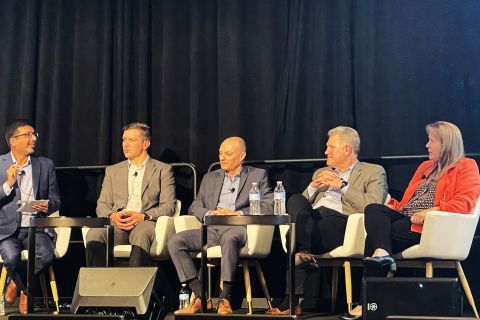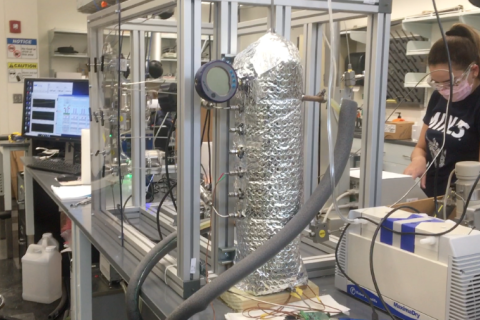Presented by:

This article appears in the E&P newsletter. Subscribe to the E&P newsletter here.
According to a September 2021 article in National Law Review, Bloomberg tracked almost 300 mentions of ESG on energy company earnings calls in the first quarter of the year. As focus on ESG gains momentum in the oil and gas industry, some E&P company solutions, including optimized hydraulic fracturing designs, are becoming increasingly relevant. The article noted that "E&P companies can indeed look at water recycling in fracking to address the 'E' component." The apparent implication is produced water.
Most operators would like to use more produced water for hydraulic fracturing, significantly reducing water disposal and reliance on fresh water. The main issue with a higher ratio of produced water is that water variability in quality causes unpredictability in pumping pressures. This, in turn, increases pumping costs and fuel consumption (and, by extension, emissions). Universal Pressure Pumping (UPP) has developed a new frac fluid optimization process with various friction reducers (FRs), and a wide variety of water qualities allows a higher percentage of produced water utilization while maintaining cost efficiency traditionally seen with freshwater-based fluids.
FRs are necessary to reduce the frictional effects (extra pressure) as water is pumped down the long pipe (wellbore) during the hydraulic fracture treatment. Produced water has elevated levels of constituents, which reduces the effectiveness of FRs. Therefore, it is more important than ever for pre-job testing to ensure the proper FR is selected for the application. Traditionally pre-job testing for FRs includes extensive water analysis, compatibility testing with other chemistry and flowloop analysis.
Flowloop analysis is a standard laboratory test used to evaluate friction pressure losses of fluid before and after the incorporation of designed chemistry. Test results are expressed as a percentage of friction reduction of chemically treated fluid versus the untreated base fluid. Although flowloop usage has been a good benchmark for comparative analysis between products, historically, there have been limitations to methods correlating this to predictive performance in the field.
Using traditional head loss equations, a simple but highly effective wellbore pressure model was created to calculate friction pressure loss (psi/1,000 ft) for various casing configurations and treatment rates using the data collected during the flowloop analysis.
To improve turnaround time for pre-job testing, a list of best-fit products is defined by using UPP's database of flowloop analysis for hundreds of commercially available FRs. The testing of highest-performing candidate FRs is then executed to confirm baseline assumptions and identify the best efficiency points for FR and produced water percentage.
With percent friction reduction confirmed for a refined list of fluids, additional well and treatment parameters are input to create a prediction of treatment parameters that can be used to create a field-optimized fluid system.
To aid in the optimization process, the following parameters are calculated on a per-fluid basis:
- Average treatment pressure as a function of treatment rate or position in lateral;
- Average treatment rate;
- Pump time;
- Hydraulic horsepower;
- Fuel volume and cost;
- FR volume and cost; and
- Percent of stages completed at the designed rate.
Besides primary treatment outputs, ESG improvements and relative cost savings can be quantified by measurements that include but are not limited to:
- Chemicals (type and volume used);
- Reduction in delivery truck traffic (chemicals and fuel);
- Reduction in produced water disposal (disposal cost and trucking);
- Decreased horsepower requirements (fuel usage and horsepower charges); and
- Lower carbon emissions.
Equipped with this information, operators can lower total treatment costs and improve their ESG footing by making the best use of resources available.
This frac fluid optimization process has been applied for more than a year in the Permian and Eagle Ford basins for multiple operators, generating data using various FRs and concentrations that confirm flowloop results and pressure calculations. Since the inception of the frac fluid optimization process, there has been a high degree of correlation between predicted and actual treatment pressure when the model is calibrated to average fracture gradients and treatment rates. While working with a West Texas operator, an average difference of only 3.6% was observed over a year time frame across 30-plus multistage laterals. ESG improvements are further quantified by comparing the optimized FR chemical package to the original fluid design.
The optimization process uses an extensive database coupled with a simple but effective method of selecting appropriate FRs. It has been proven effective because it equips the operator with the proper pre-job analysis to choose the FR that best fits its cost structure and ESG initiatives. This predictive analysis approach to fluid selection can be applied to any field in any basin utilizing a slickwater treatment.
About the author: Jesse Street is a senior technical adviser for Universal Pressure Pumping Inc. in Midland, Texas. He started his career with Calfrac Well Services in 2012 before joining Universal in 2013 as a field engineer in Connellsville, Pa. He has also served as a crew engineer and alliance engineer in the Northeast for Universal.
Recommended Reading
Exclusive: Silixa’s Distributed Fiber Optics Solutions for E&Ps
2024-03-19 - Todd Chuckry, business development manager for Silixa, highlights the company's DScover and Carina platforms to help oil and gas operators fully understand their fiber optics treatments from start to finish in this Hart Energy Exclusive.
Fracturing’s Geometry Test
2024-02-12 - During SPE’s Hydraulic Fracturing Technical Conference, industry experts looked for answers to their biggest test – fracture geometry.
Going with the Flow: Universities, Operators Team on Flow Assurance Research
2024-03-05 - From Icy Waterfloods to Gas Lift Slugs, operators and researchers at Texas Tech University and the Colorado School of Mines are finding ways to optimize flow assurance, reduce costs and improve wells.
Defeating the ‘Four Horsemen’ of Flow Assurance
2024-04-18 - Service companies combine processes and techniques to mitigate the impact of paraffin, asphaltenes, hydrates and scale on production—and keep the cash flowing.
2023-2025 Subsea Tieback Round-Up
2024-02-06 - Here's a look at subsea tieback projects across the globe. The first in a two-part series, this report highlights some of the subsea tiebacks scheduled to be online by 2025.





